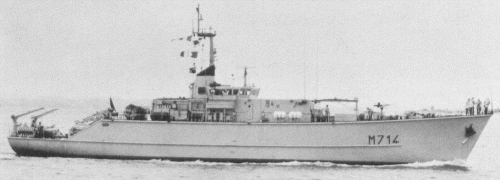
NAVYPEDIA
 Support the project with paypal
Support the project with paypal
Photo

Clio 1979
Ships
Name |
No |
Yard No | Builder |
Laid down |
Launched |
Comp |
Fate |
|---|---|---|---|---|---|---|---|
| Cybèle | M712 | CMN, Cherbourg | 15.9.1970 | 2.3.1972 | 28.9.1972 | decommissioned 7.1997, to Turkey 12.1998 (Erdek) | |
| Calliope | M713 | CMN, Cherbourg | 4.4.1970 | 20.10.1971 | 28.9.1972 | decommissioned 2.1997, to Turkey 7.1998 (Edincik) | |
| Clio | M714 | CMN, Cherbourg | 4.9.1969 | 10.6.1971 | 18.5.1972 | decommissioned 3.1997, to Turkey 1.1999 (Erdemli) | |
| Circé | M715 | CMN, Cherbourg | 30.1.1969 | 15.12.1970 | 18.5.1972 | decommissioned 2.1997, to Turkey 8.1998 (Edremit) | |
| Cérès | M716 | CMN, Cherbourg | 2.2.1971 | 10.8.1972 | 8.3.1973 | decommissioned 4.1998, to Turkey 10.1998 (Enez) |
Technical data
| Displacement standard, t | 423 |
|---|---|
| Displacement full, t | 508 |
| Length, m | 46.5 pp 50.9 oa |
| Breadth, m | 8.90 |
| Draught, m | 3.60 max |
| No of shafts | 1 |
| Machinery | 1 MTU diesel / 2 electric propulsors |
| Power, h. p. | 1800 / 520 |
| Max speed, kts | 15 |
| Fuel, t | diesel oil |
| Endurance, nm(kts) | 3000(12) |
| Armament | 1 x 1 - 20/90 MIT-20F2, 2 PAP-104 USV, 6 mineclearing divers |
| Electronic equipment | DRBN-32 radar, DUBM-20 sonar |
| Complement | 47 |
Standard scale images

Circé 1980
Graphics
Project history
The world's first purpose-built minehunters, the Circé class were designed round the DUBM-20 minehunting sonar and the PAP-104 minehunting vehicle, which was handled by the large articulated davit mounted on die stern. The system can detect mines laid to a depth of 60m at a maximum range of 500m from the ship. No sweep gear was fitted. The sonar and operations control room were housed in the superstructure block forward of the bridge. Cérès was fitted with the prototype EVEC automatic plotting table, which was subsequently retro-fitted to the other units.
A low magnetic signature and silent operation were design priorities. As insufficient expertise with GRP had been acquired it was decided that the hull should be of sandwich construction, with blocks of wood and foam inside an outer skin of wood. The outer skin was coated with a film of GRP to ease maintenance. The deckhead and superstructure were a composite of wood and glass resin.
There were two independent propulsion systems, one specifically for minehunting operations. The latter comprised two 'active rudders' each with a small crew propeller mounted at its base, energised by a 260hp electric motor. All propulsion machinery can be operated either from the bridge or from a soundproof control room located above the main deck.
Modernizations
mid-1980s, all: - DUBM-20 sonar; + DUBM-20A sonar
mid-1990s, all: - DRBN-32 radar, DUBM-20A sonar; + DRBN-34A radar, DUBM-20B sonar
Naval service
No significant events.
1979
 HOME
HOME FIGHTING SHIPS OF THE WORLD
FIGHTING SHIPS OF THE WORLD FRANCE
FRANCE MINE WARFARE SHIPS
MINE WARFARE SHIPS CIRCÉ minehunters (1972 - 1973)
CIRCÉ minehunters (1972 - 1973)
